My favorite time to plant avocado trees is March; my second favorite is October. So I might be planting some this month, and you might want to, too. Then what? How to water the new tree?
In the last handful of years I have established most of my newly planted avocado trees on drip irrigation. I wouldn’t say it’s the best way for everyone, but it has been simple and effective for me, and I’ve seen it work well in many other yards and on many farms.
I’ll show you a few key aspects to my current method, used in my yard. I’ll also show you a few variations used on farms, noting their pros and cons.
MY YARD
Three emitters
My best results have come from using three emitters to water a newly planted avocado tree.
I place one emitter right next to the trunk because that is where the roots are on a newly planted tree. This emitter is absolutely necessary. Then I place an emitter on either side, spaced six to 18 inches from the trunk. (The spacing within that range hasn’t appeared to make a difference in my experience.)
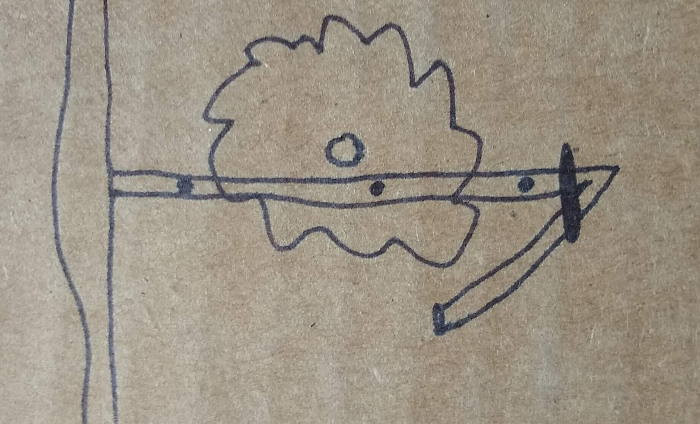
The two side emitters serve two functions. One, they allow the tree’s roots to expand because they wet soil beyond where the roots are at planting. (Roots will only grow in soil that has moisture.) Two, they give the baby tree some resiliency to competition from big plants nearby. In a yard situation, there is often an older tree or other established plant close enough to grow roots into the zone where the baby avocado is being irrigated. That older plant will rapidly start to drink the water given to the avocado. But I’ve noticed that when I expand the irrigated zone around the baby avocado, as with the three emitters, it withstands the root competition better than if I only give more water volume through one or two emitters.
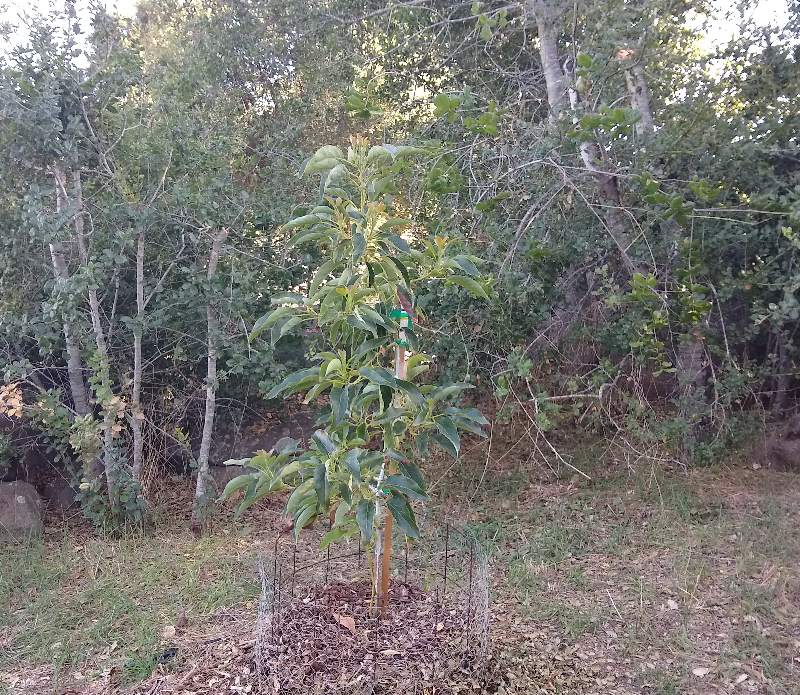
Extra line
If you’re lucky, your newly planted avocado tree will grow fast. The bigger it gets, the more water it needs. You can run the system for longer, but eventually the tree will need additional emitters.
My favorite way to plan for this is to include extra drip tubing at the time of planting, from the beginning. So instead of just using enough tubing for three emitters, I leave it long enough to have five or six.
At planting, the tubing can be folded to only allow three emitters to run. Later, as necessary, the tubing can be unfolded to allow more emitters to run. This is easier than using an adapter to connect more tubing.
Have a look at this video showing an example with a tree I planted this spring:
FARMS
If you have more than a couple trees or a full farm, you’ll probably want to use a different layout. You’ll likely plant your trees in rows, and you’ll run a single tube down the entire row.
Here is an example of trees at Cal Poly San Luis Obispo started on a single line of drip irrigation:
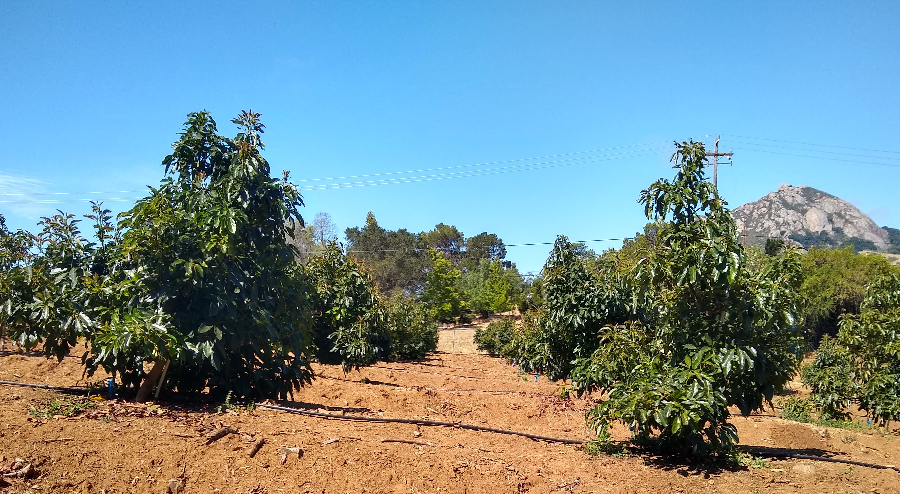
These trees all had three emitters placed under them at planting time, just as I do in my yard.
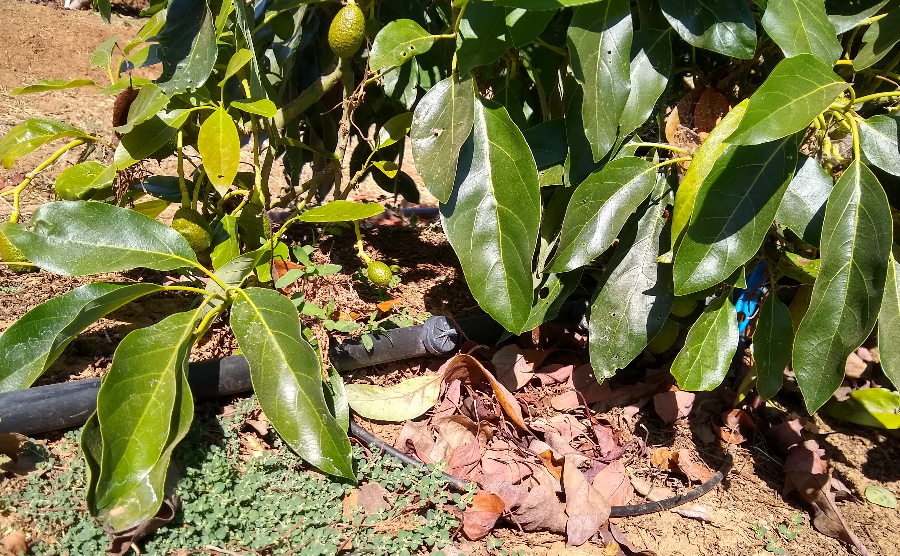
The emitters under the Cal Poly trees were punched into the tube, but you can alternatively put in spaghetti tubes that have button emitters on the ends:
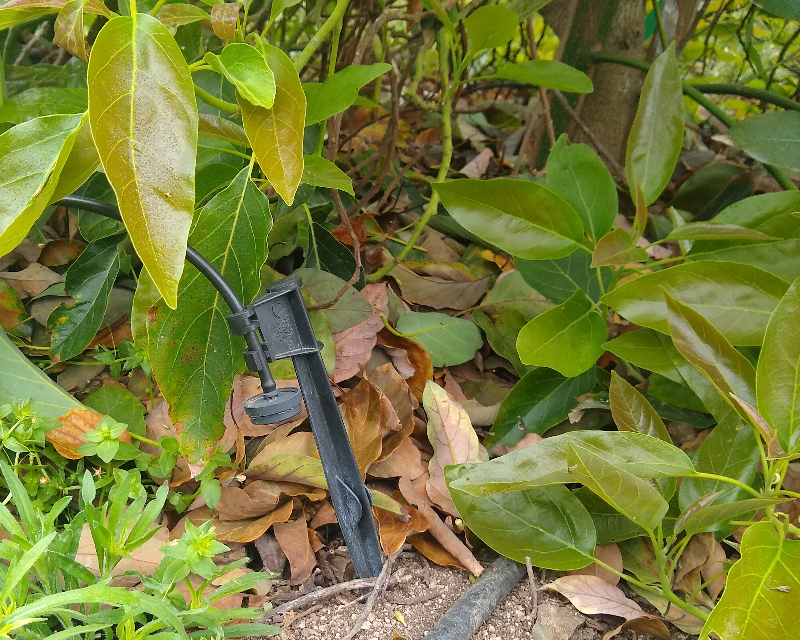
One advantage of this is that you can move the emitters away from the trunk as the tree gets bigger and its roots reach farther.
Drip tube with inline emitters
Another way to start trees on drip in a farm situation is with tubing that already has emitters built in, called “inline” emitters. The emitters can be placed every 12 inches or 18 inches or other spacings. With inline drip tubing, you just lay a single tube down the row next to the trunks of the young trees.
But some farmers choose to use double driplines, two tubes, in which case they’ll likely never need to add any more tubes or emitters as the trees get bigger.
Here is an example of double driplines with inline emitters on a newly planted avocado tree:

The downside of using inline emitters (single or double) is that you waste some water in the first year or two since the young trees’ roots haven’t yet reached the dirt being wet down the row in between the trees. A way of mitigating this is to plant something else between the trees, just for the first year or two. I’ve seen growers plant pumpkins, melons, and cover crop mixes with oats and peas to make use of those emitters.

More to think about
What about how long to run the drip system on newly planted avocado trees? Which emitters are best — 0.5 gallons per hour, 2 gallons per hour, etc? Should you cover the driplines with mulch? How do you expand the drip system as the trees get bigger? Is drip as good as sprinklers for avocados anyway? Even better?
I have answered some of these questions in other posts. See:
How to water a newly planted avocado tree
Watering fruit trees with drip irrigation
How much an how often to water avocado trees in California
I will answer others in upcoming posts.
Thank you for your support of my Yard Posts.
All of my Yard Posts are listed HERE




I do a ring of dripline around each tree! I only have a few trees though.
Hi Jessica,
Rings work too! But the danger with rings on a newly planted tree is that the emitters will be too far from the trunk, and so they won’t be wetting the rootball during the critical first few weeks and months; they’ll only, or mostly, be wetting the dirt outside of the rootball. I’ve seen new trees struggle when watered with rings because of this.
But if you’re aware of this risk and make sure to get at least one emitter right by the trunk, then a ring can still get the job done.
By the way, I use rings of dripline on my avocado trees after a couple years. At that point, the trees have expanded their roots and rings always work well.
Ahh I see, this makes sense for young trees. I do a small ring, a valve, and a second ring to make it easier to expand later. I found I still had to add more dripline this year though– the canopy expanded way faster than I expected!
Awesome problem to have!
Yes, I feel very lucky that they’re growing! It’s not very cost effective to use a valve + a coupler on each tree if you have a larger scale operation, but since I only have a few trees, I don’t mind paying for the learning experience about what works best. I ran PVC to each individual tree, and I definitely ran it too close to the trunks; I’ll probably have to move it as the trunk expands. I’m finding that you’re right about trees growing roots specifically where the water is. I expanded the ring on my peach tree by a lot, and I can see it struggling even though it’s getting more water and the dripline is right under the canopy now. I should have taken your advice to wait until winter to move irrigation! Or increased the ring in stages. It doesn’t look horrible though. I think it’ll recover. Looking forward, do I increase the ring every year until the tree reaches final size or only for the first few years? Seems like it would get huge!
Hi Greg: This is one of your best posts and it’s so timely (planning on planting a GWEN) in next weeks and it has so many useful reflated links. I end up reading them all again and watching the videos as well. On a new avocado would it be overkill to to use an Antelco microsprinkler on a spike with a pressure control valve inline? Could it be too little water with the pressure control cranked down for a 18” radius? Thank you for your excellent post.
Hi Joe,
This is a great question. I’ve played with this many times on my trees, and what I’ve found is that unless the pressure is high enough (valve is open enough) so that the spray radius is at least around three feet, the sprinkler tends to stop spinning or spin intermittently and not do its job well.
So on new trees I use either drip or sprayers. Once the tree has a canopy big enough to justify a watering pattern that is wide enough to make a sprinkler spin reliably, then that Antelco microsprinkler can be used with confidence.
Note that there are microsprinklers that come with deflectors so that they can be used on small trees too. I don’t know of Antelcos that have such deflectors, but many other brands do.
I’m very glad to see you teaching the value and principles of drip irrigation. I converted all mine to drip before we had this last wet winter. What has worked for me is to run PVC to the tree and use a bubbler head while the tree is still young and then convert to drip in rings around the tree after it gets larger size. I use Gro Power and humic compost over the drip units. That makes it easy to line trim the grass that grows up and helps keep the moisture in. In spring I use a combination of compost and mulch to feed/protect the roots. So far it is working!
Hi Greg
We have a 30 year old grafted hass/fuerte tree. It now has unripe green avocados and on the same branch brown skinned avocados.
I can send pictures.
Any thoughts as to why. The tree is a great producer and never produced the brown skinned avocados.
Hi Jay,
It sounds like you are describing thrips damage. It is worse this year than I’ve ever seen. Read more on thrips on avocados here.
Hi Greg, thanks for all the great info. I’m in Costa Mesa and your watering table seems to be working great here too. Since April I’ve used the bucket with holes method to meter the water dose which really helped the new trees thrive more consistently. I’m looking forward to running the inline emitters this fall as you described above.
My avocado tree is over 40 years old. I’m unsure as to the type. The fruit has a thin skin, and the meat has a rich buttery taste. Best tasting avocado in all the world! I live in LA county. The tree has a brick planter around the base, it’s about 2′ tall x 4′ x 4′ wide. There is grass on two sides of planter and brick/concrete on two sides. I want to add drip irrigation. Question: do I need to place the emitters close to the base? Also, how many emitters, how long each day & how many days per week?
Have you ever tried using micro sprinklers? They wet a nice even circular pattern around the tree. That is what I use for my avocado trees based on advice from an avocado farmer I know. The only downside is you have to keep the leaves and branches about a foot off of the ground otherwise it blocks the sprinkler stream.
Is there a local nursery in the San Diego area that sells trees from Brokaw nursery?
I have a 7 citrus trees in the ground since yesterday and they are about 200 ft from the water source/contoller. The trees are about 30 ft lower in elevation on the property from the contoller/source. They are not in a line. My thought is to run pvc pipe from the controller to the trees underground and then run the pvc underground between the trees and T off to risers with the pvc at about 2 feet from the trunks. Trenching for all this whole idea is done. Use a multiple head at the risers to run 1/4 inch tubing for micro sprayer and possibly drip for each tree.
My questions are is this a good plan? Will the roots break the schedule 40 pvc in between trees? Would you use schedule 80? And, how far from the trunks would you bring the pvc risers? Is it better to bring the water to the 7 trees with underground pvc and then go with one riser and then go with 5/8″ black tubing and T off to each tree above ground like in your videos?
I do have gophers, rabbits and coyotes. One of those animals has chewed on 1/4″ black tubing for a drink on my avocados once before.
Any thoughts are greatly appreciated. I’ve learned a lot from your posts.